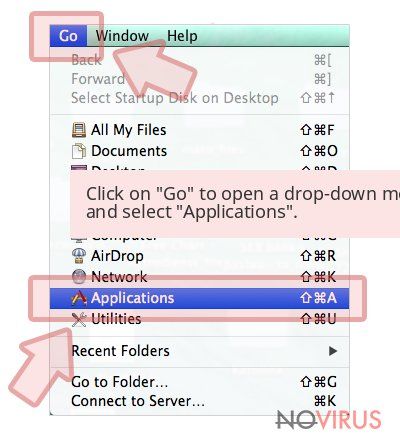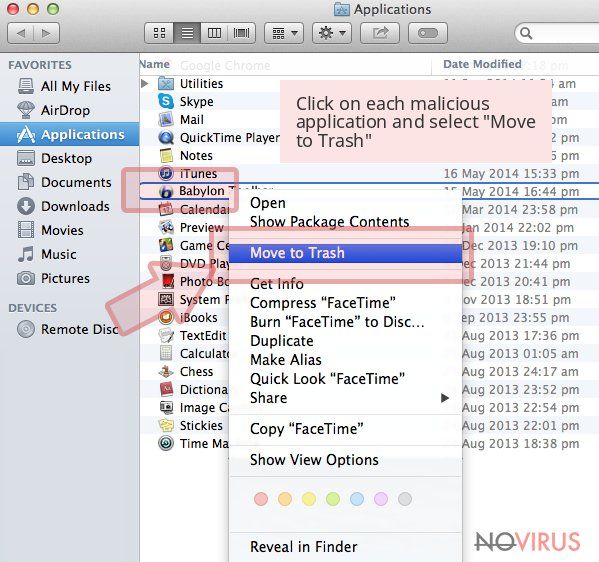Remove WebNavigatorBrowser (Clear Removal Instructions) - Free Removal Instructions
WebNavigatorBrowser Removal Guide
Description of WebNavigatorBrowser
WebNavigatorBrowser is browser hijacker that severely impedes browsing performance
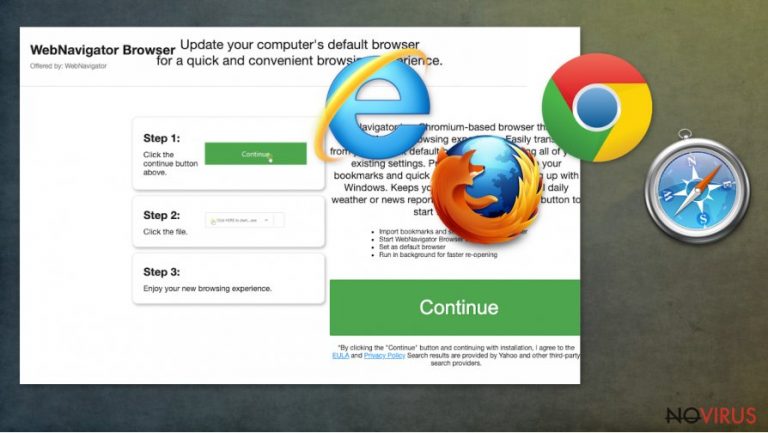
WebNavigatorBrowser is a type of potentially unwanted program (PUP) that causes interferences and detectable browser decelerations by redirecting users to sponsored websites and always displaying intrusive pop-up ads. Although this PUP isn't categorised as dangerous malware, it can still alter system files and startup items. Pop-up ads can trick people into downloading some additional malicious software that could do more harm.
After successful installation, the WebNavigatorBrowser virus will automatically change user browser settings, such as the default search engine, homepage, new tab, and so on. All the searches the computer user now initiates will go through the mischievous domain, thus displaying promotional sites first and not necessarily showing the desired, proper search results.
| Name | WebNavigatorBrowser |
|---|---|
| Type | PUP, Browser hijacker, Adware |
| Symptoms | All browser settings changed including default search engine, new tab, homepage. Intrusive pop-up ad displays |
| Distribution | Freeware bundle installations with pre-ticked boxes are the most common way for PUPs to spread. |
| Issues | Privacy issues due to data tracking practices, installation of other potentially unwanted programs, monetary losses |
| Removal | To remove WebNavigatorBrowser properly from the infected device, use a reliable anti-malware software |
| System fix | Anti-malware software isn't enough. To repair any damage that the virus caused to system files, use FortectIntego tool to automatically find and restore altered data |
Browser hijacking isn't a new thing. Companies like Better Cloud Solutions are creating adware like WebNavigatorBrowser virus to get revenue from sponsored websites. There are plenty of similar applications created by the same developer, e.g., WebExplorer. Creators are assuring that this Chromium-based web browser will improve users' browsing experience by showing some exclusive material, enhanced search results, and so on. When in reality, it just impedes browsing practice.
This kind of potentially unwanted program is usually hidden in freeware bundles. That's the primary method of WebNavigatorBrowser hijacker distribution. When gullible users agree to install some freeware and use express installation, these types of PUPs get in the computer systems.
If a user has the product of Better Cloud Solutions in their device but would like to get rid of it, use a reliable anti-malware software like SpyHunter 5Combo Cleaner or Malwarebytes. Either of these apps will automatically remove WebNavigatorBrowser along with all it's installed add-ons.
In most cases, WebNavigationBrowser removal isn't enough if other malicious programs were also found on the device. Malware might have made some changes to the registry or other vital Windows system files. That may cause the affected device to exhibit abnormal behaviour, such as lag, crashing, etc. To restore the computer to its normal state, we recommend using FortectIntego to repair the devices' registry and other essential features.
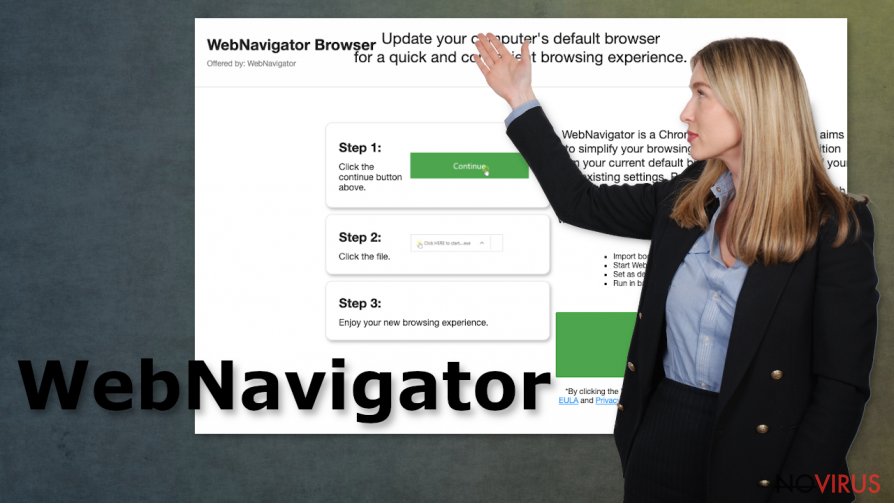
PUP distribution methods
Usually, unaware users receive potentially unwanted programs when downloading some freeware bundles. In this day and age, everyone is rushing. When installing freeware, look closely at what you agree to. Don't rush, don't choose the express installation. That's where browser hijackers catch unconcerned users. Use advanced or custom installation options and carefully look for pre-ticked boxes. If users really want the original freeware that they downloaded, uncheck all the other boxes, agreeing to install additional apps.
PUPs aren't very hazardous malware, but it could still ruin someone's' day. If users are not careful and tend to visit shady websites, they should always have a dependable anti-malware software to protect them from various threats
WebNavigatorBrowsers removal from computer system
If a user received this PUP unwillingly, or he's not satisfied with the product, he should use anti-malware software to delete it properly. To remove WebBrowserNavigator virus infection automatically, use SpyHunter 5Combo Cleaner or Malwarebytes. People should always have trustworthy antivirus software to watch their backs.
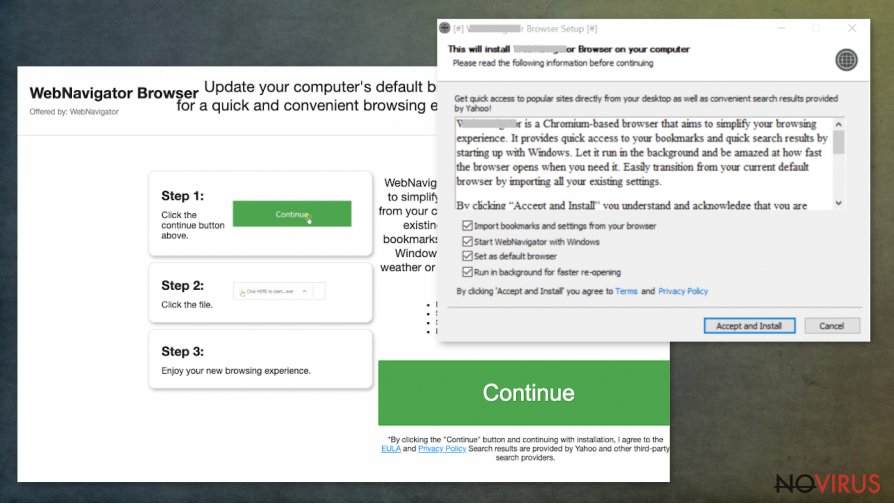
After the WebBrowserNavigator removal is complete, you should also check and clean your web browsers. In some cases, potentially unwanted programs leave their settings intact within the web browsers, even after they are eliminated. Thus, clean cache, data, and other unwanted components.
You may remove virus damage with a help of FortectIntego. SpyHunter 5Combo Cleaner and Malwarebytes are recommended to detect potentially unwanted programs and viruses with all their files and registry entries that are related to them.
Getting rid of WebNavigatorBrowser. Follow these steps
Uninstall WebNavigatorBrowser in Windows systems
Uninstall potentially unwanted programs from Windows systems:
Terminate suspicious programs from Windows 10/8 machines by following these instructions:
- Type Control Panel into Windows search and once the result shows up hit Enter.
- Under Programs, choose Uninstall a program.
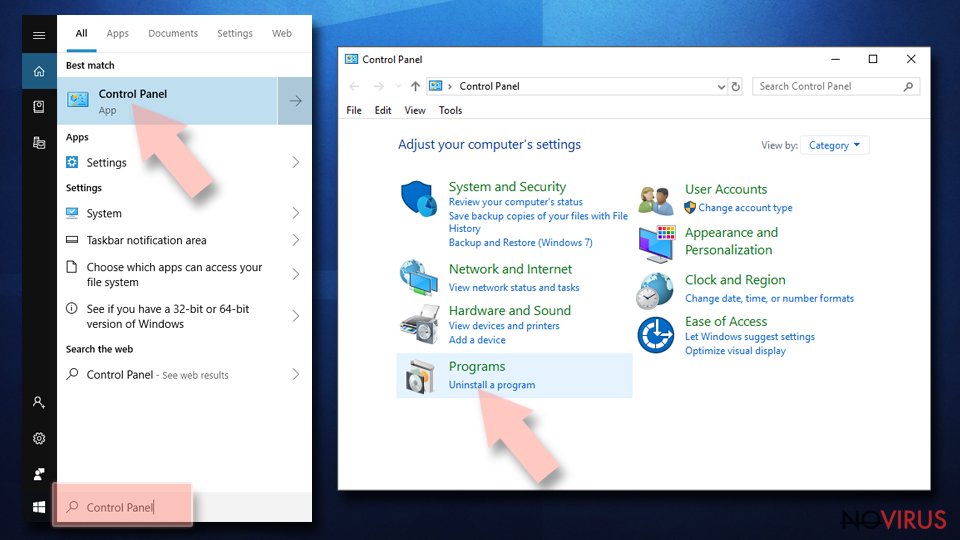
- Find components related to suspicious programs.
- Right-click on the application and select Uninstall.
- Click Yes when User Account Control shows up.
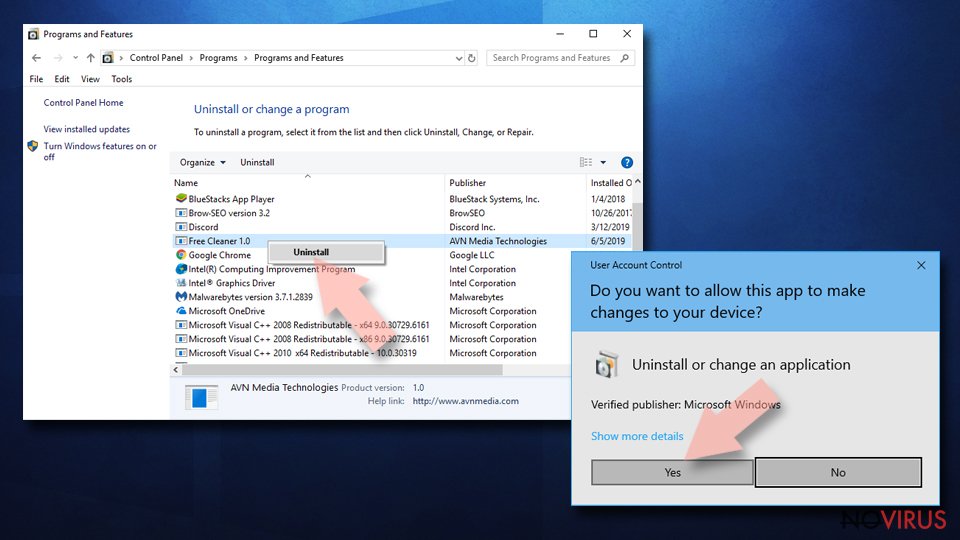
- Wait for the process of uninstallation to be done and click OK.
Windows 7/XP instructions:
- Click on Windows Start and go to Control Panel on the right pane.
- Choose Add/Remove Programs.
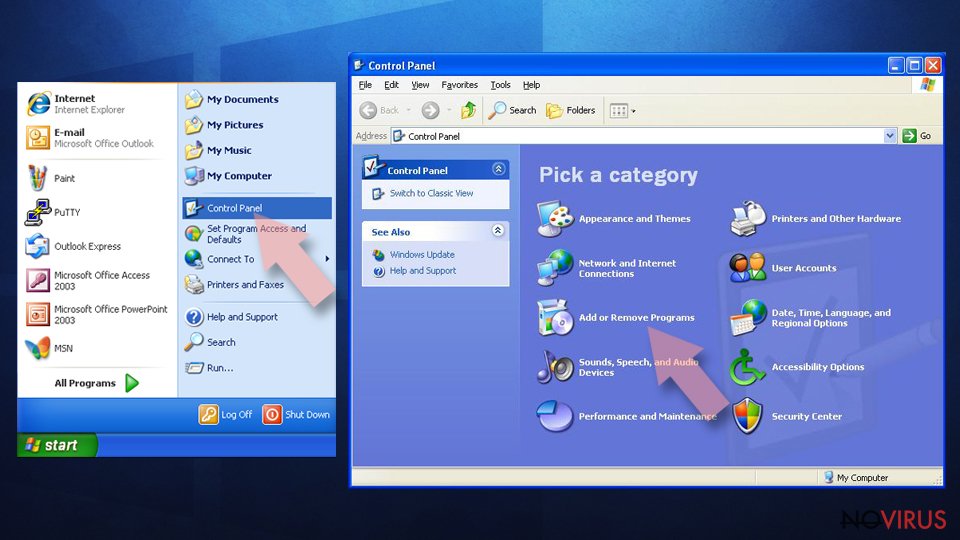
- Select Uninstall a program under Programs in Control Panel.
- Click once on the unwanted application.
- Click Uninstall/Change at the top.
- Confirm with Yes.
- Click OK and finish the removal.
Uninstall WebNavigatorBrowser in Mac OS X system
-
Users who use OS X should click on Go button, which can be found at the top left corner of the screen and select Applications.

-
Wait until you see Applications folder and look for WebNavigatorBrowser or any other suspicious programs on it. Now right click on every of such entries and select Move to Trash.

Delete WebNavigatorBrowser from Microsoft Edge
Delete suspicious extensions from MS Edge:
- Go to the Menu by clicking on the three horizontal dots at the top-right.
- Then pick Extensions.
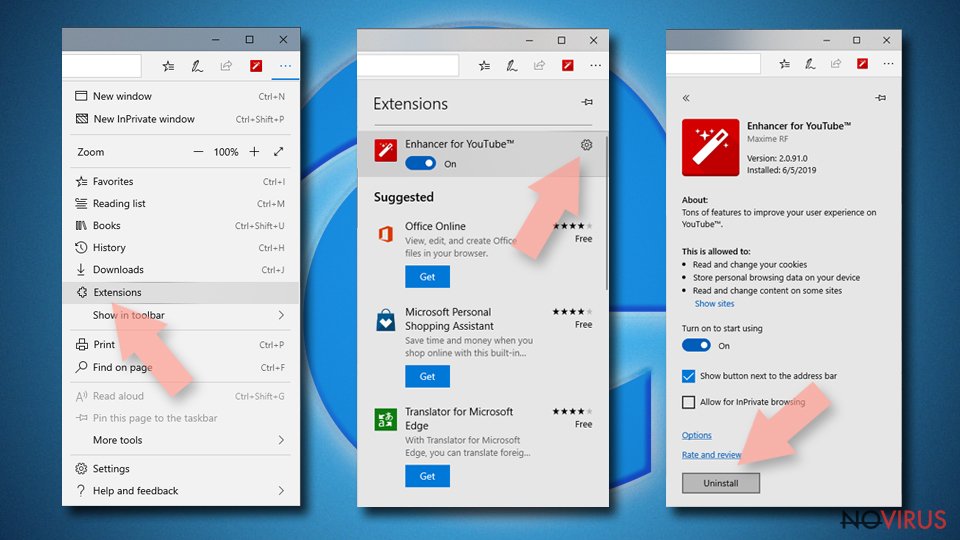
- Choose the unwanted add-ons on the list and click on the Gear icon.
- Click on Uninstall at the bottom.
Clear cookies and other data:
- Click on the Menu and from the context menu select Privacy & security.
- Under Clear browsing data, select Choose what to clear.
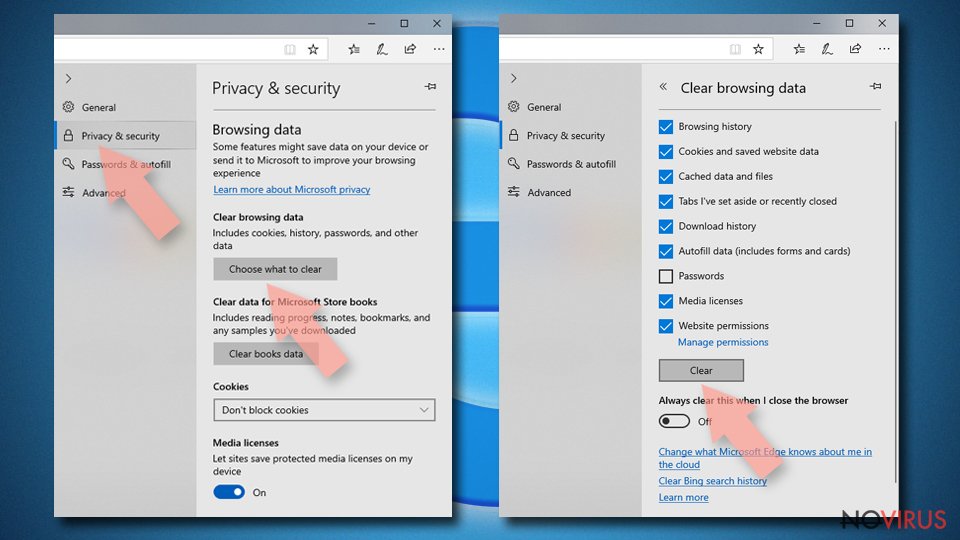
- Choose everything except passwords, and click on Clear.
Alter new tab and homepage settings:
- Click the menu icon and choose Settings.
- Then find On startup section.
- Click Disable if you found any suspicious domain.
Reset MS Edge fully:
- Click on the keyboard Ctrl + Shift + Esc to open Task Manager.
- Choose More details arrow at the bottom.
- Go to Details tab.
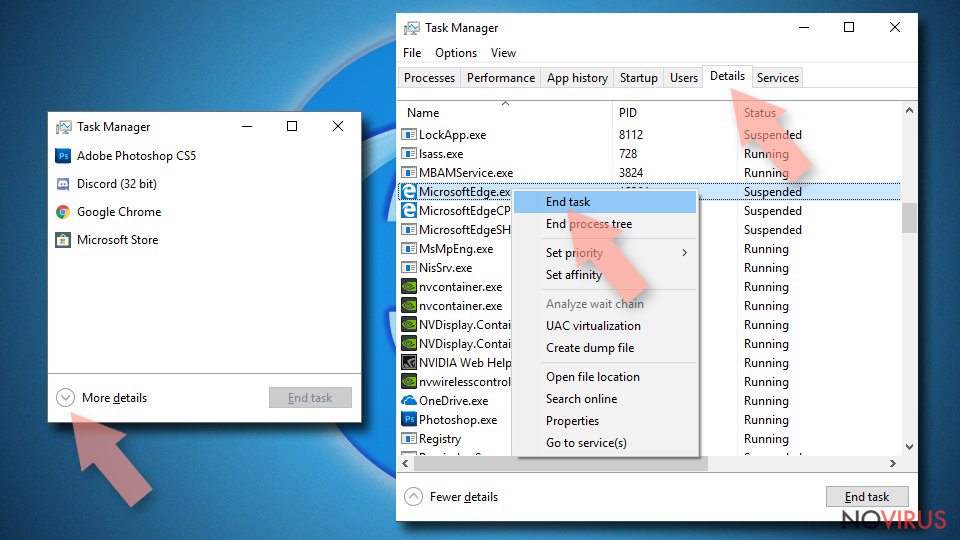
- Now scroll down and locate every entry with Microsoft Edge name in it.
- Right-click on each of them and select End Task to stop MS Edge from running.
When none of the above solves the issue, you might need an advanced Edge reset method, but you need to backup your data before proceeding.
- Find the following folder on the PC: C:\\Users\\%username%\\AppData\\Local\\Packages\\Microsoft.MicrosoftEdge_8wekyb3d8bbwe.
- Press Ctrl + A on your keyboard to select all folders.
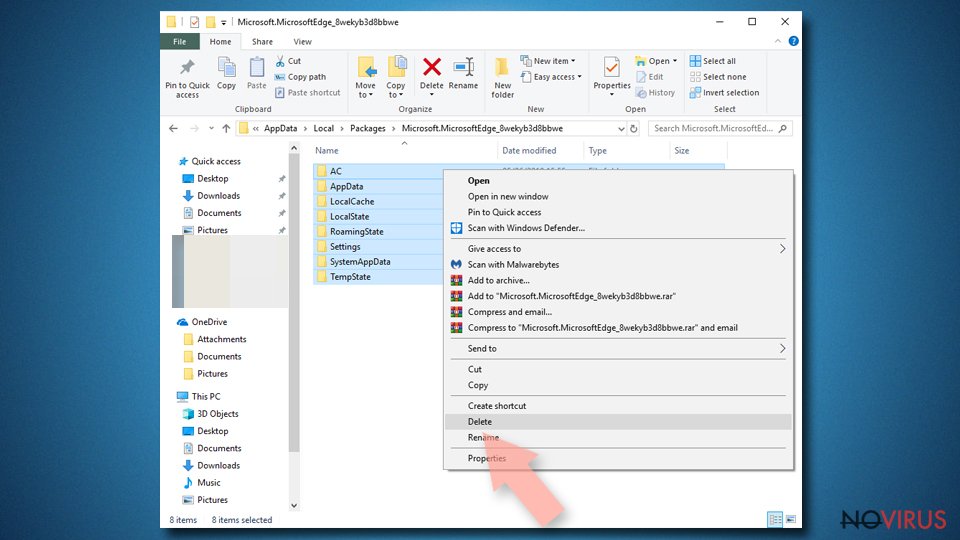
- Right-click on the selection and choose Delete
- Right-click on the Start button and pick Windows PowerShell (Admin).
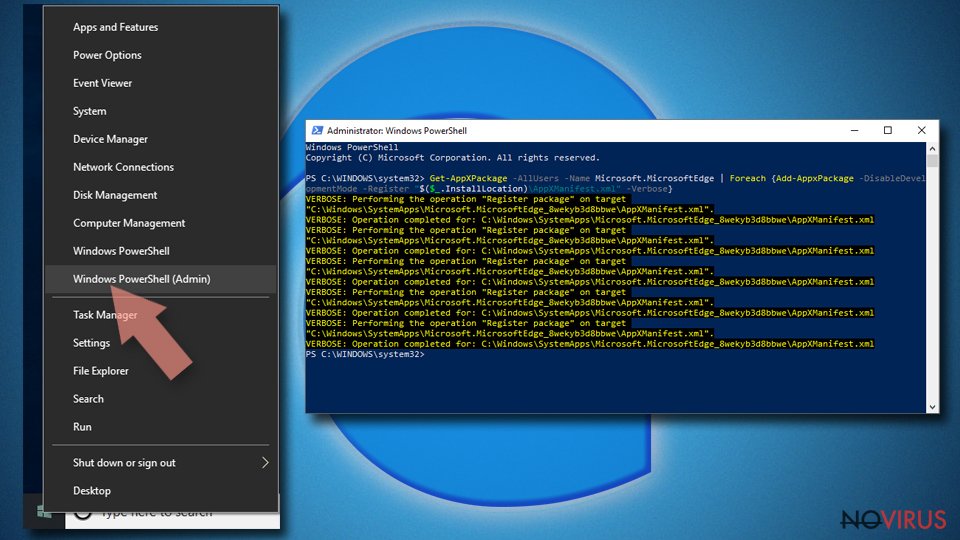
- Copy and paste the following command, and then press Enter:
Get-AppXPackage -AllUsers -Name Microsoft.MicrosoftEdge | Foreach {Add-AppxPackage -DisableDevelopmentMode -Register “$($_.InstallLocation)\\AppXManifest.xml” -Verbose
Instructions for Chromium-based Edge
Delete extensions:
- Open Edge and click Settings.
- Then find Extensions.
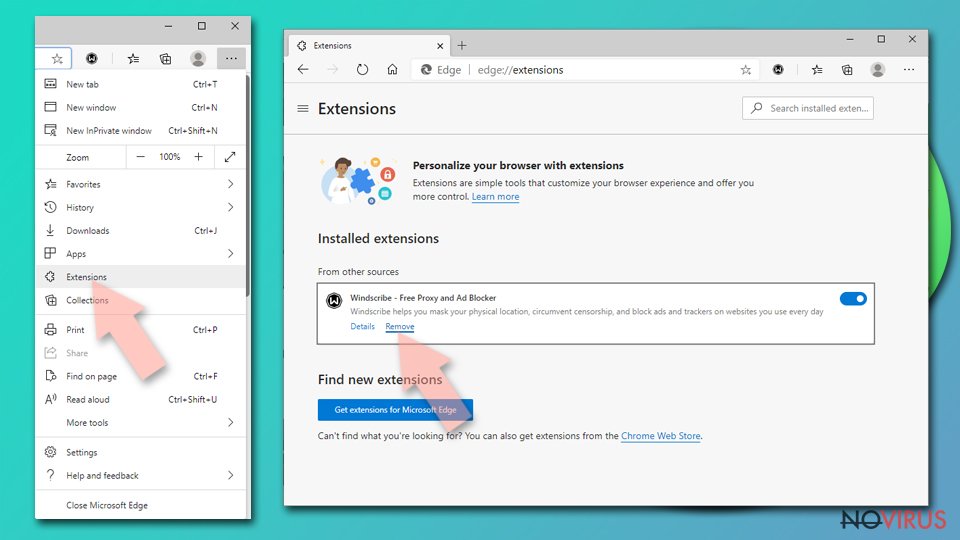
- Delete unwanted extensions with the Remove.
Clear cache and site data:
- Click on Menu and then Settings.
- Find Privacy and services.
- Locate Clear browsing data, then click Choose what to clear.
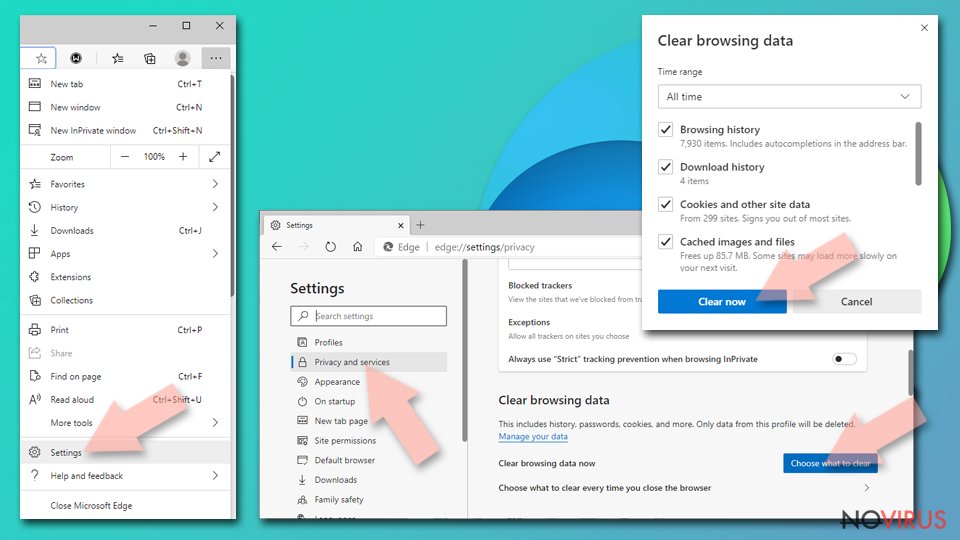
- Time range.
- Click All time.
- Select Clear now.
Reset Chromium-based MS Edge browser fully:
- Go to Settings.
- On the left side, choose Reset settings.
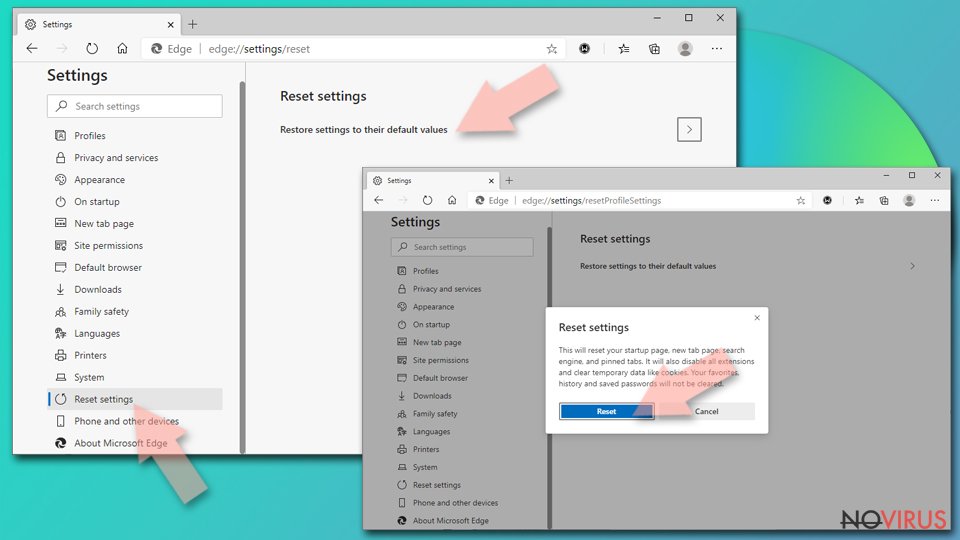
- Select Restore settings to their default values.
- Click Reset.
Delete WebNavigatorBrowser from Mozilla Firefox (FF)
Delete all the suspicious extensions from Mozilla Firefox:
Remove suspicious Firefox extensions:
- Open Mozilla Firefox browser and click on the three horizontal lines at the top-right to open the menu.
- Select Add-ons in the context menu.
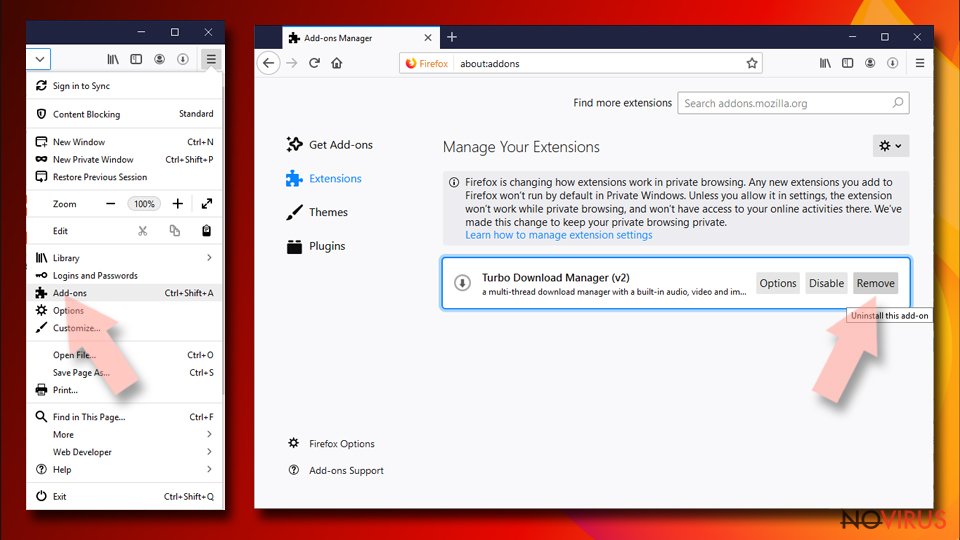
- Choose plugins that are creating issues and select Remove.
Reset the homepage on the browser:
- Click three horizontal lines at the top right corner.
- This time select Options.
- Under Home section, enter your preferred site for the homepage that will open every time you launch Mozilla Firefox.
Clear cookies and site data:
- Click Menu and pick Options.
- Find the Privacy & Security section.
- Scroll down to choose Cookies and Site Data.
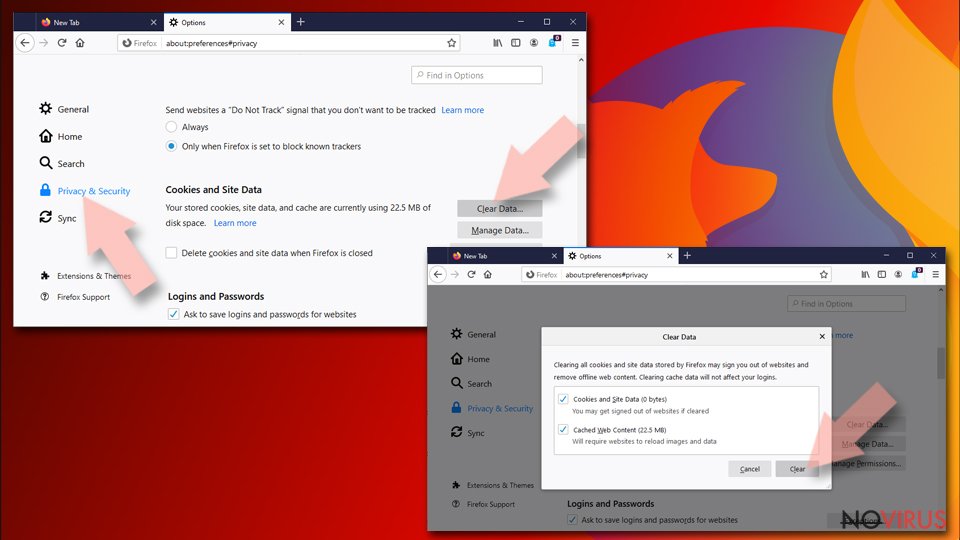
- Click on Clear Data… option.
- Click Cookies and Site Data, Cached Web Content and press Clear.
Reset Mozilla Firefox:
If none of the steps above helped you, reset Mozilla Firefox as follows:
- Open Mozilla Firefox and go to the menu.
- Click Help and then choose Troubleshooting Information.
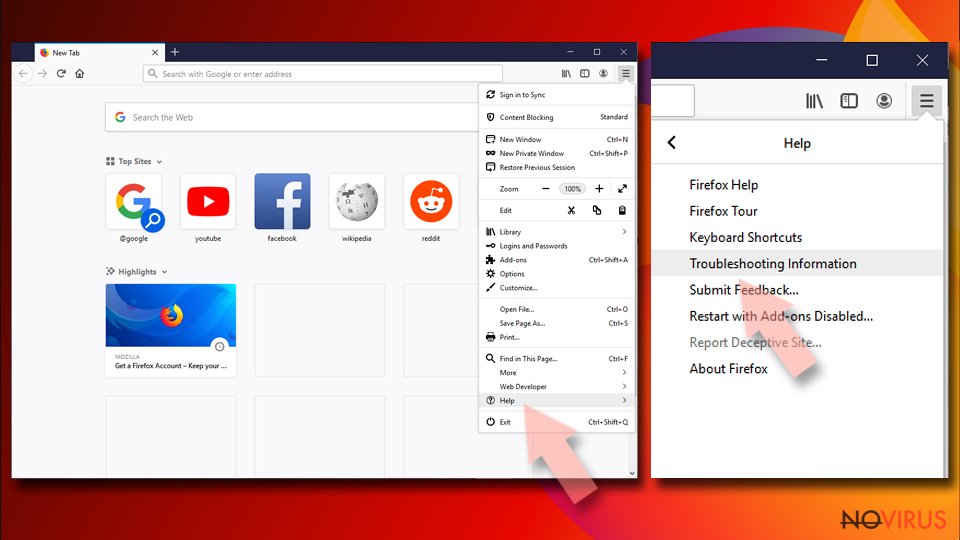
- Locate Give Firefox a tune-up section, click on Refresh Firefox…
- Confirm the action by pressing on Refresh Firefox on the pop-up.
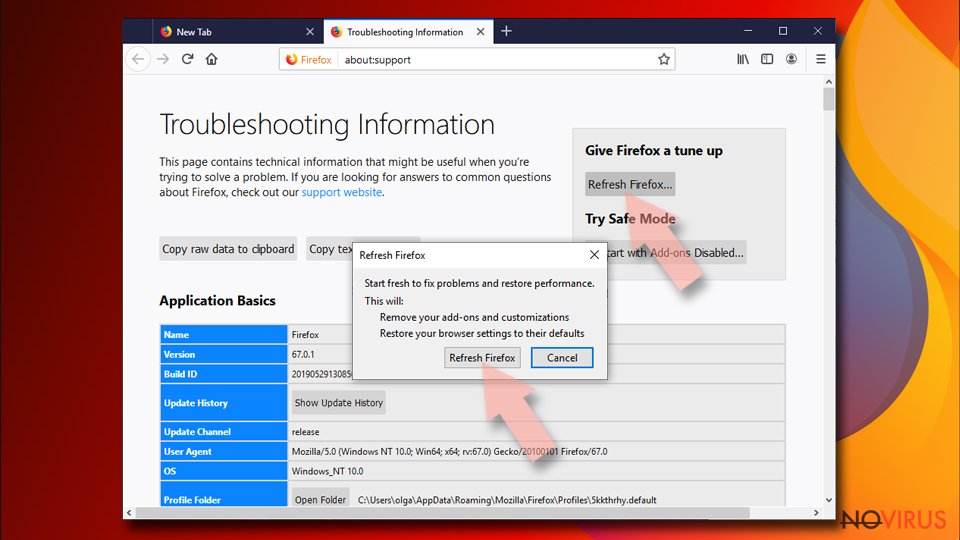
Chrome browser reset
Clean Google Chrome web browser to ensure that the virus does not return:
Find and remove suspicious extensions from Google Chrome:
- In Google Chrome, open the Menu by clicking three vertical dots at the top-right corner.
- Select More tools > Extensions.
- Once the window opens, you will see all the installed extensions.
- Find any suspicious add-ons related to any PUP.
- Uninstall them by clicking Remove.
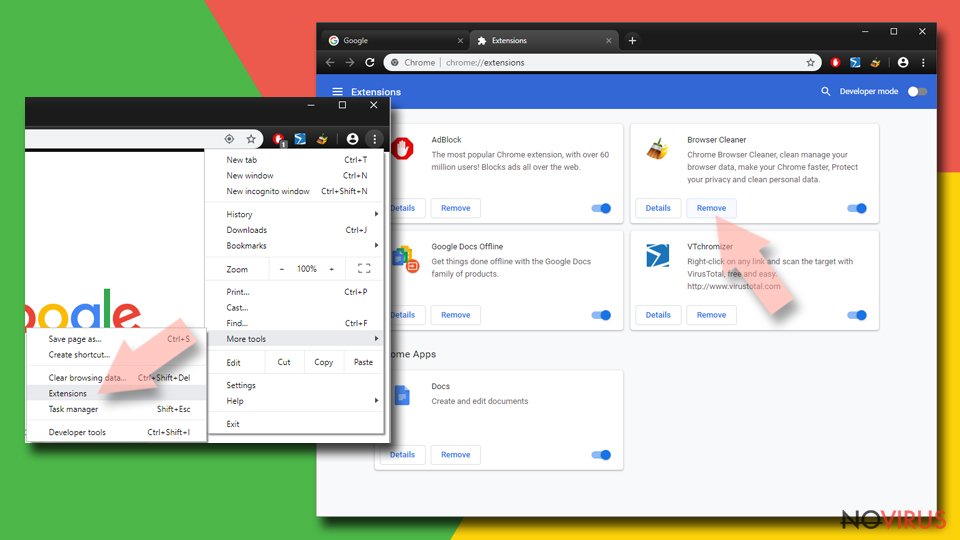
Clear cache and web data from Chrome:
- Click the Menu and select Settings.
- Find Privacy and security section.
- Choose Clear browsing data.
- Select Browsing history.
- Cookies and other site data, also Cached images and files.
- Click Clear data.
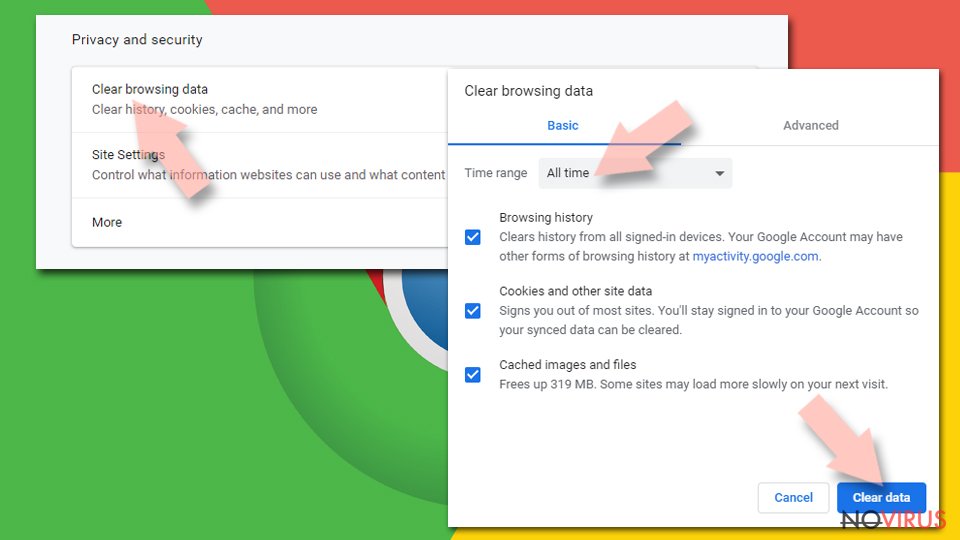
Alter settings of the homepage:
- Go to the menu and choose Settings.
- Find odd entries in the On startup section.
- Click on Open a specific or set of pages.
- Then click on three dots and look for the Remove option.
Reset Google Chrome fully:
You might need to reset Google Chrome and properly eliminate all the unwanted components:
- Go to Chrome Settings.
- Once there, scroll down to expand Advanced section.
- Scroll down to choose Reset and clean up.
- Click Restore settings to their original defaults.
- Click Reset settings again.

Delete WebNavigatorBrowser from Safari
Get rid of questionable extensions from Safari:
- Click Safari.
- Then go to Preferences…
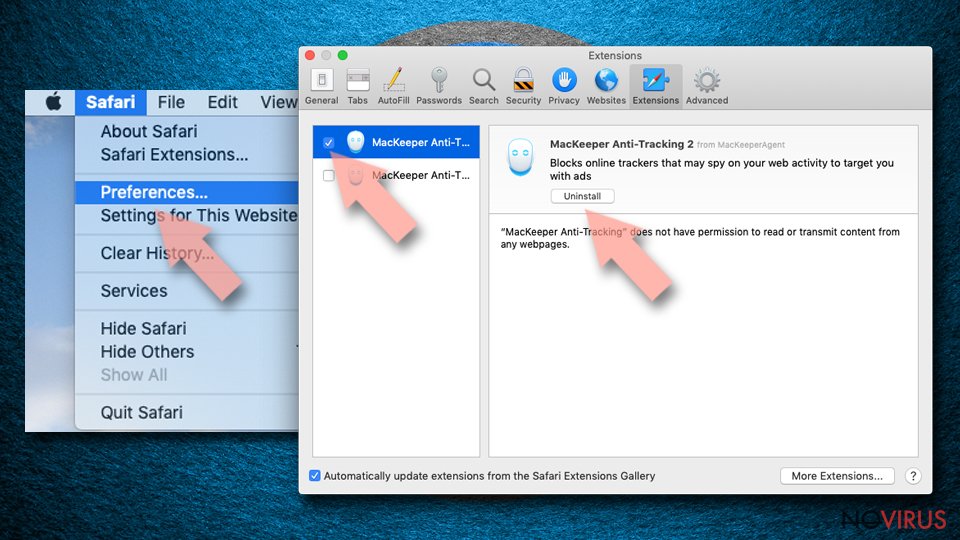
- Choose Extensions on the menu.
- Select the unwanted extension and then pick Uninstall.
Clear cookies from Safari:
- Click Safari.
- Choose Clear History…
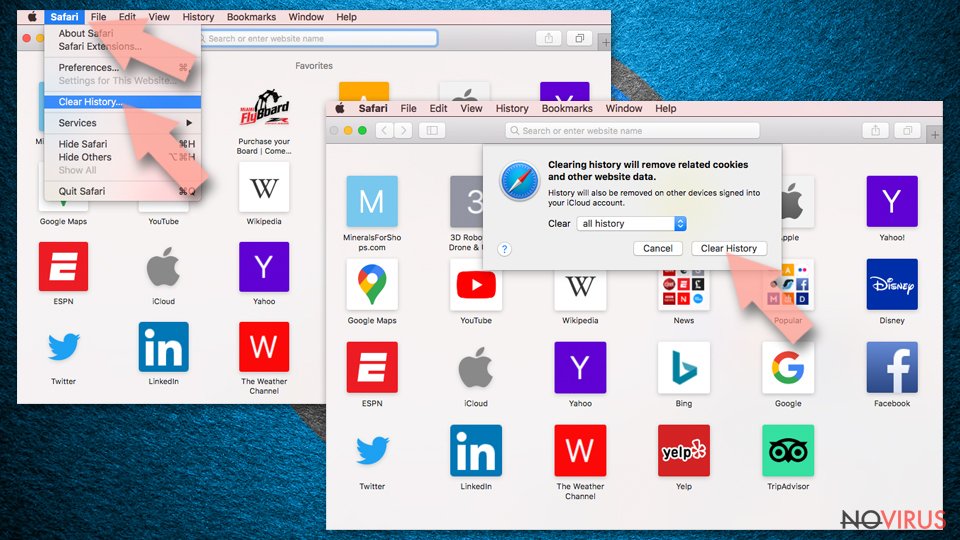
- From the drop-down menu under Clear, find and pick all history.
- Confirm with Clear History.
Reset Safari fully:
- Click Safari and then Preferences…
- Choose the Advanced tab.
- Tick the Show Develop menu in the menu bar.
- From the menu bar, click Develop.
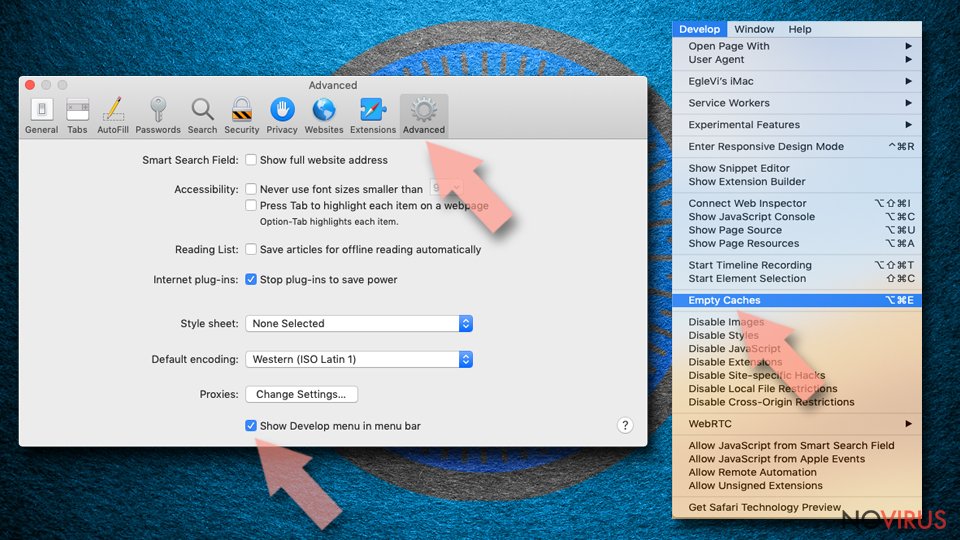
- Then select Empty Caches.
Even if you have completed all the steps above, we still strongly recommend you to scan your computer system with a powerful anti-malware software. It is advisable to do that because an automatic malware removal tool can detect and delete all remains of WebNavigatorBrowser, for instance, its registry keys. The anti-malware program can help you to easily detect and eliminate possibly dangerous software and malicious viruses in an easy way. You can use any of our top-rated malware removal programs: FortectIntego, SpyHunter 5Combo Cleaner or Malwarebytes.
How to prevent from getting browser hijackers
Securely connect to your website wherever you are
Sometimes you may need to log in to a content management system or server more often, especially if you are actively working on a blog, website, or different project that needs constant maintenance or that requires frequent content updates or other changes. Avoiding this problem can be easy if you choose a dedicated/fixed IP address. It's a static IP address that only belongs to a specific device and does not change when you are in different locations.
VPN service providers such as Private Internet Access can help you with these settings. This tool can help you control your online reputation and successfully manage your projects wherever you are. It is important to prevent different IP addresses from connecting to your website. With a dedicated/fixed IP address, VPN service, and secure access to a content management system, your project will remain secure.
Reduce the threat of viruses by backing up your data
Due to their own careless behavior, computer users can suffer various losses caused by cyber infections. Viruses can affect the functionality of the software or directly corrupt data on your system by encrypting it. These problems can disrupt the system and cause you to lose personal data permanently. There is no such threat if you have the latest backups, as you can easily recover lost data and get back to work.
It is recommended to update the backups in parallel each time the system is modified. This way, you will be able to access the latest saved data after an unexpected virus attack or system failure. By having the latest copies of important documents and projects, you will avoid serious inconveniences. File backups are especially useful if malware attacks your system unexpectedly. We recommend using the Data Recovery Pro program to restore the system.
